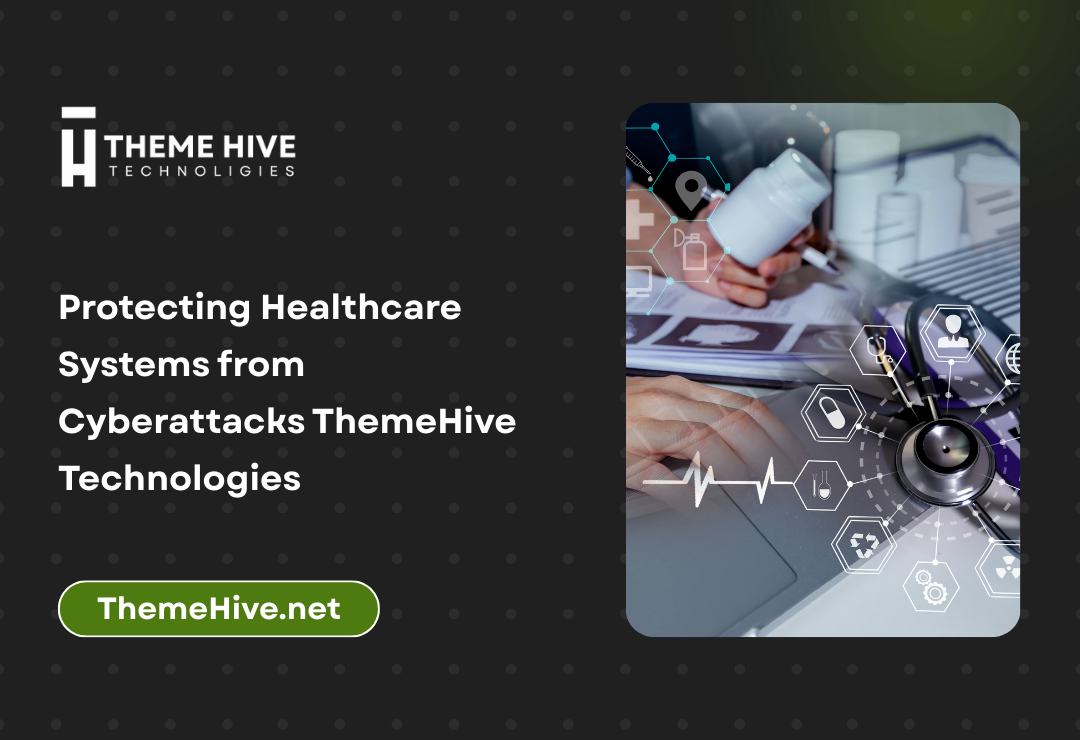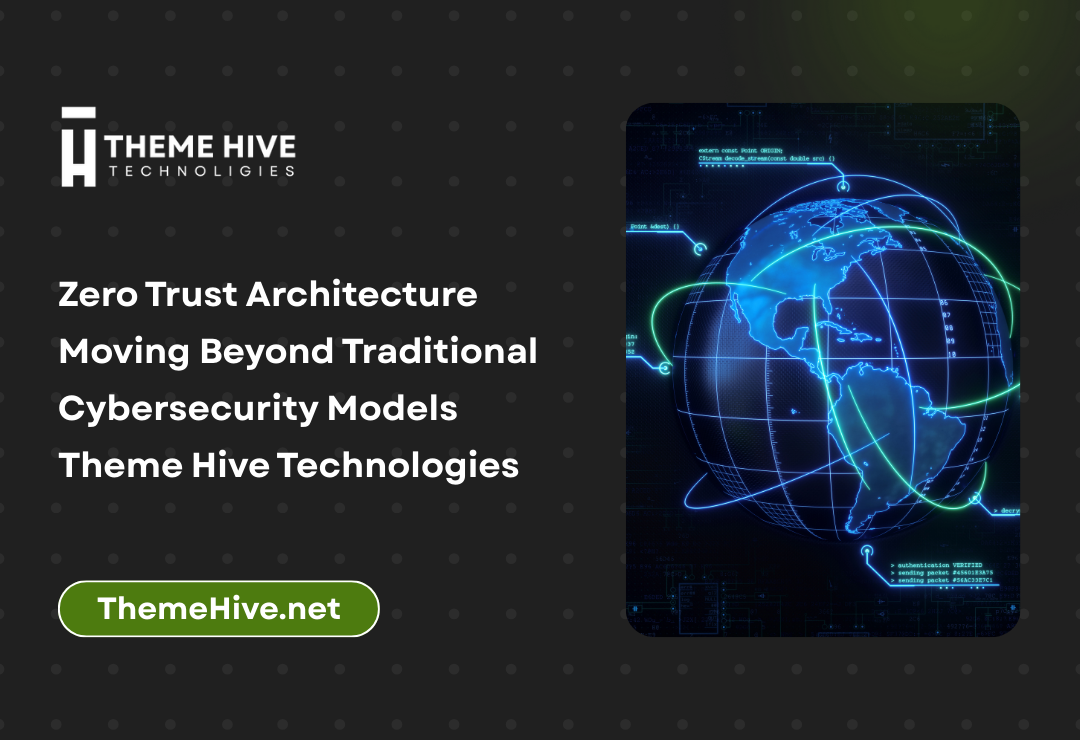The healthcare industry has become one of the most targeted sectors for cyberattacks, with healthcare data breaches costing organizations an average of $10.9 million per incident according to recent IBM Cost of Data Breach studies. As medical facilities increasingly rely on digital infrastructure, protecting healthcare systems from cyberattacks has become a critical priority for healthcare providers worldwide. ThemeHive Technologies understands the unique challenges facing healthcare organizations in today’s digital landscape and the importance of implementing robust cybersecurity measures.
Understanding the Healthcare Cybersecurity Landscape
The Rising Threat to Healthcare Systems
Healthcare organizations face an unprecedented level of cyber threats, with attacks increasing by over 55% in recent years according to Cybersecurity and Infrastructure Security Agency (CISA) reports. The sensitive nature of patient data, combined with often outdated IT infrastructure, makes healthcare systems particularly vulnerable to malicious actors. From ransomware attacks that can shut down entire hospital networks to data breaches that compromise millions of patient records, the stakes have never been higher.
The COVID-19 pandemic further accelerated digital transformation in healthcare, introducing new vulnerabilities as organizations rapidly deployed telehealth solutions and remote monitoring systems. This digital expansion, while beneficial for patient care, has created additional entry points that cybercriminals actively exploit.
Why Healthcare is a Prime Target
Healthcare organizations are attractive targets for several reasons. First, medical records contain comprehensive personal information including Social Security numbers, insurance details, and complete medical histories, making them significantly more valuable than credit card information on the dark web. Second, healthcare systems often operate with legacy technology that lacks modern security features, creating easy access points for attackers.
The critical nature of healthcare services also means organizations are more likely to pay ransoms to restore operations quickly, making ransomware attacks particularly lucrative for cybercriminals. Theme Hive Technologies recognizes these unique vulnerabilities and emphasizes the importance of proactive cybersecurity measures tailored specifically for healthcare environments.
Common Types of Healthcare Cyberattacks
Ransomware Attacks
Ransomware represents the most significant threat to healthcare systems today. These attacks encrypt critical data and systems, demanding payment for restoration of access. Notable incidents include the 2017 WannaCry attack that affected over 80 NHS trusts in the UK and more recent attacks on major hospital systems across the United States.
Healthcare ransomware attacks are particularly devastating because they can force hospitals to divert patients, cancel surgeries, and revert to paper-based systems, directly impacting patient care and safety. The financial impact extends beyond ransom payments to include system restoration costs, regulatory fines, and potential litigation.
Data Breaches and PHI Theft
Protected Health Information (PHI) theft remains a persistent threat, with cybercriminals targeting electronic health records for their high black-market value. These breaches often result from inadequate access controls, unencrypted data transmission, or compromised user credentials.
Phishing and Social Engineering
Healthcare workers are frequently targeted through sophisticated phishing campaigns designed to steal login credentials or deploy malware. These attacks exploit the fast-paced, high-stress healthcare environment where employees may not have time to carefully scrutinize suspicious emails.
IoT and Medical Device Vulnerabilities
The proliferation of Internet of Things (IoT) devices in healthcare settings, from infusion pumps to patient monitoring systems, has created new attack vectors. Many medical devices lack adequate security features and cannot be easily updated, making them persistent vulnerabilities in hospital networks.
Essential Cybersecurity Strategies for Healthcare Organizations
Implementing Comprehensive Risk Assessments
Effective cybersecurity begins with understanding your organization’s risk profile. Healthcare organizations should conduct regular comprehensive risk assessments that evaluate all systems, processes, and potential vulnerabilities. These assessments should include evaluation of network infrastructure, medical devices, third-party vendor access, and employee security practices.
ThemeHive Technologies specializes in conducting thorough cybersecurity assessments for healthcare organizations, helping identify critical vulnerabilities before they can be exploited. Regular assessments enable organizations to prioritize security investments and maintain compliance with healthcare regulations.
Network Segmentation and Access Controls
Network segmentation involves dividing computer networks into smaller subnetworks to limit the spread of cyberattacks. In healthcare environments, this might mean separating patient care systems from administrative networks, isolating medical devices, and creating secure zones for different types of data and operations.
Implementing robust access controls ensures that users can only access the systems and data necessary for their roles. This includes multi-factor authentication, regular access reviews, and automated provisioning and deprovisioning of user accounts.
Employee Training and Awareness Programs
Human error remains one of the leading causes of healthcare data breaches. Comprehensive cybersecurity training programs should educate staff about common threats, safe computing practices, and proper incident reporting procedures. Training should be role-specific, with clinical staff receiving different instruction than IT personnel.
Regular simulation exercises, including phishing tests and incident response drills, help reinforce training and identify areas for improvement. Theme Hive Technologies develops customized training programs that address the specific needs and challenges of healthcare environments.
Endpoint Security and Device Management
With the proliferation of mobile devices, laptops, and IoT equipment in healthcare settings, comprehensive endpoint security has become essential. This includes deploying advanced endpoint detection and response solutions, maintaining updated antivirus software, and implementing device encryption.
Medical device security requires special attention due to the often limited security capabilities of these systems. Organizations should maintain detailed inventories of all connected medical devices, implement network monitoring to detect unusual device behavior, and work with vendors to ensure timely security updates.
Technical Security Measures
Data Encryption and Backup Solutions
Encrypting data both at rest and in transit provides a critical layer of protection against unauthorized access. Healthcare organizations should implement enterprise-grade encryption solutions for all sensitive data, including patient records, financial information, and operational data.
Comprehensive backup solutions ensure data availability and support rapid recovery from cyberattacks. Backup strategies should include regular testing of restore procedures, geographically distributed backup storage, and offline backup copies that cannot be encrypted by ransomware.
Advanced Threat Detection and Response
Modern cybersecurity requires sophisticated threat detection capabilities that can identify and respond to attacks in real-time. Security Information and Event Management (SIEM) systems collect and analyze security data from across the organization to identify potential threats.
Artificial intelligence and machine learning technologies enhance threat detection by identifying unusual patterns and behaviors that may indicate cyberattacks. These systems can automatically respond to certain types of threats, reducing response times and limiting damage.
Vulnerability Management Programs
Regular vulnerability assessments and patch management are essential for maintaining secure healthcare systems. Organizations should implement automated vulnerability scanning tools and establish procedures for prioritizing and addressing identified vulnerabilities.
Patch management in healthcare environments requires careful coordination to ensure that security updates don’t interfere with critical patient care systems. This may involve testing patches in isolated environments and scheduling updates during maintenance windows.
Regulatory Compliance and Standards
HIPAA Security Requirements
The Health Insurance Portability and Accountability Act (HIPAA) establishes minimum security requirements for protecting patient health information. Healthcare organizations must implement administrative, physical, and technical safeguards to ensure PHI confidentiality, integrity, and availability.
HIPAA compliance requires regular security risk assessments, workforce training programs, incident response procedures, and comprehensive documentation of security measures. Organizations must also ensure that business associates handling PHI maintain appropriate security protections.
Additional Healthcare Security Frameworks
Beyond HIPAA, healthcare organizations should consider implementing additional security frameworks such as NIST Cybersecurity Framework, HITRUST CSF, or ISO 27001. These frameworks provide comprehensive guidelines for establishing and maintaining effective cybersecurity programs.
ThemeHive Technologies assists healthcare organizations in achieving and maintaining compliance with various security standards and regulations, ensuring that security measures align with industry best practices and regulatory requirements.
Incident Response and Recovery Planning
Developing Comprehensive Response Plans
Effective incident response planning enables healthcare organizations to quickly contain cyberattacks, minimize damage, and restore normal operations. Response plans should clearly define roles and responsibilities, communication procedures, and step-by-step response actions for different types of incidents.
Plans should address the unique challenges of healthcare environments, including procedures for maintaining patient care during cyber incidents, coordinating with clinical staff, and managing public communications about data breaches.
Business Continuity and Disaster Recovery
Healthcare organizations must maintain operations even during significant cyber incidents. Business continuity planning should identify critical systems and processes, establish alternative procedures for maintaining patient care, and define recovery time objectives for different systems.
Disaster recovery plans should include detailed procedures for restoring systems and data, testing and validation processes, and communication strategies for keeping stakeholders informed during recovery efforts.
Post-Incident Analysis and Improvement
Following any cybersecurity incident, organizations should conduct thorough post-incident analyses to identify lessons learned and opportunities for improvement. This includes evaluating the effectiveness of response procedures, identifying system vulnerabilities that enabled the attack, and implementing measures to prevent similar incidents.
Third-Party Vendor Risk Management
Assessing Vendor Security Practices
Healthcare organizations increasingly rely on third-party vendors for various services, from cloud hosting to medical device maintenance. Each vendor relationship introduces potential cybersecurity risks that must be carefully managed through comprehensive vendor risk assessment programs.
Vendor assessments should evaluate security policies, technical controls, compliance certifications, and incident response capabilities. Organizations should require vendors to demonstrate adequate security measures and maintain cyber insurance coverage.
Contract Security Requirements
Vendor contracts should include specific cybersecurity requirements, including data protection standards, incident notification procedures, and audit rights. Contracts should clearly define responsibilities for data security and specify remediation requirements in the event of security incidents.
Theme Hive Technologies helps healthcare organizations develop comprehensive vendor risk management programs that protect against supply chain cyber threats while maintaining necessary business relationships.
Emerging Technologies and Future Considerations
Artificial Intelligence and Machine Learning
AI and machine learning technologies offer significant potential for enhancing healthcare cybersecurity through improved threat detection, automated response capabilities, and predictive risk assessment. However, these technologies also introduce new security considerations related to data privacy, algorithmic bias, and model security.
Cloud Security Considerations
As healthcare organizations increasingly adopt cloud-based solutions, cloud security becomes a critical consideration. Organizations must carefully evaluate cloud provider security capabilities, understand shared responsibility models, and implement appropriate controls for cloud-based data and applications.
Zero Trust Architecture
Zero Trust security models assume that no user or device should be trusted by default, requiring continuous verification of access requests. This approach is particularly relevant for healthcare environments with diverse user populations and numerous connected devices.
Building a Security-First Culture
Leadership Commitment and Governance
Successful cybersecurity programs require strong leadership commitment and effective governance structures. Healthcare executives must prioritize cybersecurity investments, establish clear accountability for security outcomes, and ensure that security considerations are integrated into all business decisions.
Board-level oversight of cybersecurity risks helps ensure that security receives appropriate attention and resources. Regular reporting on security metrics, incident trends, and compliance status keeps leadership informed and engaged.
Continuous Improvement and Adaptation
Cybersecurity is not a one-time project but an ongoing process that must evolve with changing threat landscapes and organizational needs. Healthcare organizations should establish continuous improvement processes that regularly evaluate and enhance security measures.
This includes staying informed about emerging threats, participating in information sharing initiatives, and learning from the experiences of other healthcare organizations. ThemeHive Technologies provides ongoing security consulting services that help organizations maintain and improve their cybersecurity posture over time.
Conclusion
Protecting healthcare systems from cyberattacks requires a comprehensive, multi-layered approach that addresses technology, processes, and people. As cyber threats continue to evolve and intensify, healthcare organizations must remain vigilant and proactive in their security efforts.
The implementation of robust cybersecurity measures is not just a technical requirement but a fundamental responsibility to patients who trust healthcare organizations with their most sensitive information. By following the strategies and best practices outlined in this guide, healthcare organizations can significantly reduce their cyber risk while maintaining the operational efficiency necessary for quality patient care.
ThemeHive Technologies remains committed to supporting healthcare organizations in their cybersecurity journey, providing expert guidance, comprehensive solutions, and ongoing support to protect against evolving cyber threats. Through strategic planning, proper implementation, and continuous monitoring, healthcare systems can build resilient defenses that protect both patient data and operational continuity.
For healthcare organizations looking to strengthen their cybersecurity posture, the time to act is now. The cost of prevention will always be less than the cost of recovery, and patient safety depends on maintaining secure, reliable healthcare systems in an increasingly digital world.
For more information about cybersecurity solutions and services for healthcare organizations, visit ThemeHive Technologies or explore our comprehensive services offerings. Stay updated with the latest cybersecurity trends and insights by reading our news and articles. To discuss your organization’s specific cybersecurity needs, contact us today. Learn more about our expertise in healthcare cybersecurity solutions.
Internal Links (5 links to your site):
- https://themehive.net/
- https://themehive.net/about/
- https://themehive.net/services/
- https://themehive.net/news-articles/
- https://themehive.net/contact-us/
Outbound Links (5 authoritative external links):
- IBM Security Data Breach Report
- CISA Healthcare Cybersecurity
- HHS HIPAA Security Rule
- NIST Cybersecurity Framework
- HITRUST CSF
- ISO 27001







